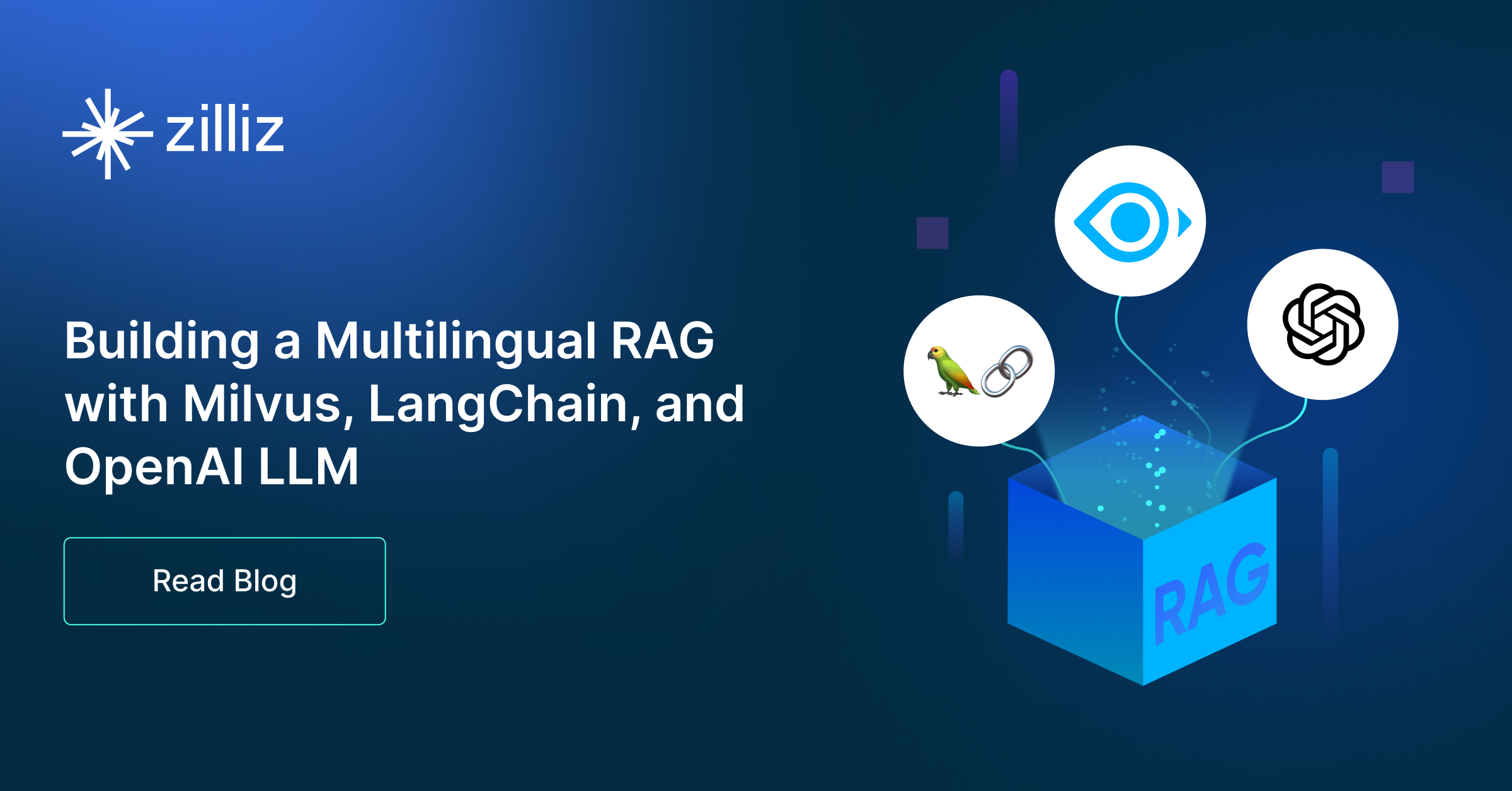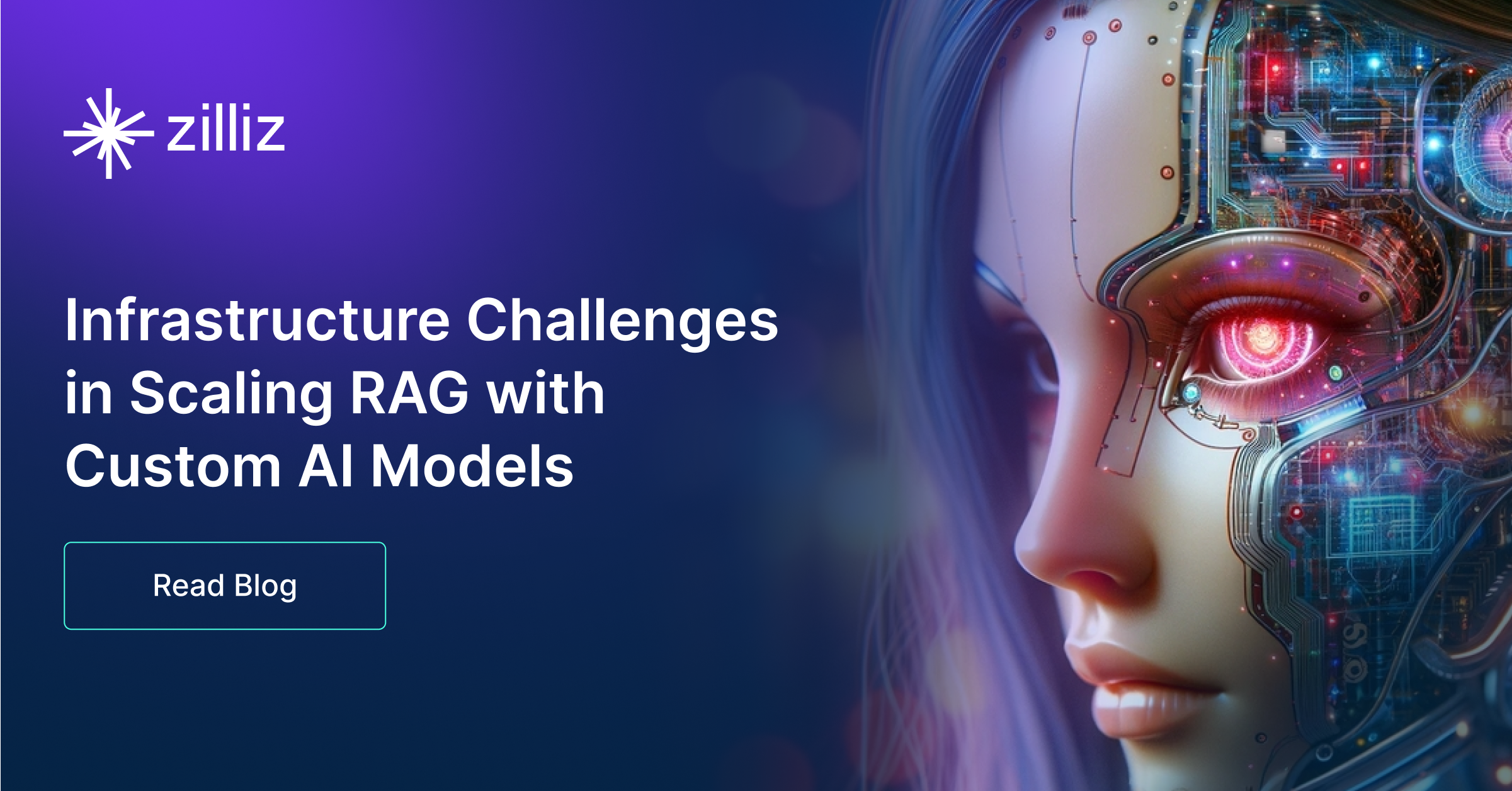Build RAG Chatbot with LangChain, OpenSearch, Google Vertex AI Gemini 2.0 Flash Thinking, and Amazon Titan Text Embeddings v2
Introduction to RAG
Retrieval-Augmented Generation (RAG) is a game-changer for GenAI applications, especially in conversational AI. It combines the power of pre-trained large language models (LLMs) like OpenAI’s GPT with external knowledge sources stored in vector databases such as Milvus and Zilliz Cloud, allowing for more accurate, contextually relevant, and up-to-date response generation. A RAG pipeline usually consists of four basic components: a vector database, an embedding model, an LLM, and a framework.
Key Components We'll Use for This RAG Chatbot
This tutorial shows you how to build a simple RAG chatbot in Python using the following components:
- LangChain: An open-source framework that helps you orchestrate the interaction between LLMs, vector stores, embedding models, etc, making it easier to integrate a RAG pipeline.
- OpenSearch: An open-source search and analytics suite derived from Elasticsearch. It offers robust full-text search and real-time analytics, with vector search available as an add-on for similarity-based queries, extending its capabilities to handle high-dimensional data. Since it is just a vector search add-on rather than a purpose-built vector database, it lacks scalability and availability and many other advanced features required by enterprise-level applications. Therefore, if you prefer a much more scalable solution or hate to manage your own infrastructure, we recommend using Zilliz Cloud, which is a fully managed vector database service built on the open-source Milvus and offers a free tier supporting up to 1 million vectors.)
- Google Vertex AI Gemini 2.0 Flash Thinking: This advanced AI model is designed for rapid, high-quality cognitive analysis and decision-making. It leverages enhanced natural language understanding and generation, enabling seamless interactions. Ideal for real-time applications in customer service, content creation, and intelligent automation, it excels in scenarios that demand quick, insightful responses.
- Amazon Titan Text Embeddings v2: This model generates high-quality text embeddings, enabling nuanced semantic understanding and similarity comparisons. It boasts enhanced performance and scalability, making it suitable for tasks such as information retrieval, recommendation systems, and sentiment analysis. Ideal for applications needing robust and efficient language representation at scale.
By the end of this tutorial, you’ll have a functional chatbot capable of answering questions based on a custom knowledge base.
Note: Since we may use proprietary models in our tutorials, make sure you have the required API key beforehand.
Step 1: Install and Set Up LangChain
%pip install --quiet --upgrade langchain-text-splitters langchain-community langgraph
Step 2: Install and Set Up Google Vertex AI Gemini 2.0 Flash Thinking
pip install -qU "langchain[google-vertexai]"
# Ensure your VertexAI credentials are configured
from langchain.chat_models import init_chat_model
llm = init_chat_model("gemini-2.0-flash-thinking-exp-01-21", model_provider="google_vertexai")
Step 3: Install and Set Up Amazon Titan Text Embeddings v2
pip install -qU langchain-aws
from langchain_aws import BedrockEmbeddings
embeddings = BedrockEmbeddings(model_id="amazon.titan-embed-text-v2:0")
Step 4: Install and Set Up OpenSearch
pip install --upgrade --quiet opensearch-py langchain-community
from langchain_community.vectorstores import OpenSearchVectorSearch
opensearch_vector_search = OpenSearchVectorSearch(
"http://localhost:9200",
"embeddings",
embedding_function
)
Step 5: Build a RAG Chatbot
Now that you’ve set up all components, let’s start to build a simple chatbot. We’ll use the Milvus introduction doc as a private knowledge base. You can replace it with your own dataset to customize your RAG chatbot.
import bs4
from langchain import hub
from langchain_community.document_loaders import WebBaseLoader
from langchain_core.documents import Document
from langchain_text_splitters import RecursiveCharacterTextSplitter
from langgraph.graph import START, StateGraph
from typing_extensions import List, TypedDict
# Load and chunk contents of the blog
loader = WebBaseLoader(
web_paths=("https://milvus.io/docs/overview.md",),
bs_kwargs=dict(
parse_only=bs4.SoupStrainer(
class_=("doc-style doc-post-content")
)
),
)
docs = loader.load()
text_splitter = RecursiveCharacterTextSplitter(chunk_size=1000, chunk_overlap=200)
all_splits = text_splitter.split_documents(docs)
# Index chunks
_ = vector_store.add_documents(documents=all_splits)
# Define prompt for question-answering
prompt = hub.pull("rlm/rag-prompt")
# Define state for application
class State(TypedDict):
question: str
context: List[Document]
answer: str
# Define application steps
def retrieve(state: State):
retrieved_docs = vector_store.similarity_search(state["question"])
return {"context": retrieved_docs}
def generate(state: State):
docs_content = "\n\n".join(doc.page_content for doc in state["context"])
messages = prompt.invoke({"question": state["question"], "context": docs_content})
response = llm.invoke(messages)
return {"answer": response.content}
# Compile application and test
graph_builder = StateGraph(State).add_sequence([retrieve, generate])
graph_builder.add_edge(START, "retrieve")
graph = graph_builder.compile()
Test the Chatbot
Yeah! You've built your own chatbot. Let's ask the chatbot a question.
response = graph.invoke({"question": "What data types does Milvus support?"})
print(response["answer"])
Example Output
Milvus supports various data types including sparse vectors, binary vectors, JSON, and arrays. Additionally, it handles common numerical and character types, making it versatile for different data modeling needs. This allows users to manage unstructured or multi-modal data efficiently.
Optimization Tips
As you build your RAG system, optimization is key to ensuring peak performance and efficiency. While setting up the components is an essential first step, fine-tuning each one will help you create a solution that works even better and scales seamlessly. In this section, we’ll share some practical tips for optimizing all these components, giving you the edge to build smarter, faster, and more responsive RAG applications.
LangChain optimization tips
To optimize LangChain, focus on minimizing redundant operations in your workflow by structuring your chains and agents efficiently. Use caching to avoid repeated computations, speeding up your system, and experiment with modular design to ensure that components like models or databases can be easily swapped out. This will provide both flexibility and efficiency, allowing you to quickly scale your system without unnecessary delays or complications.
OpenSearch optimization tips
To optimize OpenSearch in a Retrieval-Augmented Generation (RAG) setup, fine-tune indexing by enabling efficient mappings and reducing unnecessary stored fields. Use HNSW for vector search to speed up similarity queries while balancing recall and latency with appropriate ef_search and ef_construction values. Leverage shard and replica settings to distribute load effectively, and enable caching for frequent queries. Optimize text-based retrieval with BM25 tuning and custom analyzers for better relevance. Regularly monitor cluster health, index size, and query performance using OpenSearch Dashboards and adjust configurations accordingly.
Google Vertex AI Gemini 2.0 Flash Thinking optimization tips
Gemini 2.0 Flash Thinking is designed for rapid yet thoughtful responses in RAG systems. Optimize retrieval by focusing on high-confidence document matching, reducing unnecessary data processing. Keep prompts structured, providing key details upfront while avoiding excessive context. Adjust temperature settings (0.1–0.3) to fine-tune response diversity. Use caching to reduce API overhead for repeated queries. Take advantage of Google Cloud’s GPU-accelerated processing to improve throughput. If using Flash Thinking alongside larger models, assign it to medium-complexity reasoning tasks that require faster turnaround than Pro models but more depth than standard Flash.
Amazon Titan Text Embeddings v2 optimization tips
Amazon Titan Text Embeddings v2 is a scalable model that performs well in large-scale text retrieval tasks. Optimize retrieval by preprocessing input text to remove noise and focus on high-value content, which can improve the efficiency of embedding generation. Use vector compression techniques like quantization or dimensionality reduction to reduce memory and storage costs without significantly impacting retrieval accuracy. When querying, implement hybrid search strategies combining dense vector search and traditional keyword-based search to improve retrieval speed and relevance. For large-scale applications, batch text processing to reduce API calls and enhance throughput. Cache high-demand embeddings to minimize redundant processing and speed up query response times. Regularly update and retrain the embedding model to maintain accuracy with fresh data.
By implementing these tips across your components, you'll be able to enhance the performance and functionality of your RAG system, ensuring it’s optimized for both speed and accuracy. Keep testing, iterating, and refining your setup to stay ahead in the ever-evolving world of AI development.
RAG Cost Calculator: A Free Tool to Calculate Your Cost in Seconds
Estimating the cost of a Retrieval-Augmented Generation (RAG) pipeline involves analyzing expenses across vector storage, compute resources, and API usage. Key cost drivers include vector database queries, embedding generation, and LLM inference.
RAG Cost Calculator is a free tool that quickly estimates the cost of building a RAG pipeline, including chunking, embedding, vector storage/search, and LLM generation. It also helps you identify cost-saving opportunities and achieve up to 10x cost reduction on vector databases with the serverless option.
 Calculate your RAG cost
Calculate your RAG cost
What Have You Learned?
By diving into this tutorial, you’ve just unlocked the power of building a modern RAG system using cutting-edge tools! You learned how LangChain acts as the glue, seamlessly orchestrating the flow between components. OpenSearch, your vector database hero, handles the heavy lifting of storing and retrieving embeddings at scale, ensuring lightning-fast similarity searches. Google’s Vertex AI Gemini 2.0 Flash brings speed and precision to the table, generating human-like responses while keeping costs low—perfect for real-time applications. Meanwhile, Amazon Titan Text Embeddings v2 transforms your raw text into rich numerical representations, capturing meaning and context like a pro. Together, these tools form a dynamic pipeline: Titan converts data into vectors, OpenSearch organizes and retrieves them, and Gemini synthesizes answers—all smoothly coordinated by LangChain. You even discovered optimization tricks, like balancing speed and accuracy with Gemini’s lightweight Flash model and leveraging Titan’s cost-effective embeddings for large datasets. And let’s not forget the free RAG cost calculator—a game-changer for budgeting your AI projects without surprises!
Now that you’ve seen how these pieces fit together, imagine what you can build: chatbots that understand nuance, search engines that feel magical, or knowledge bases that anticipate questions. The best part? You’re equipped not just to replicate this system but to innovate. Tweak parameters, experiment with hybrid search strategies, or swap components to match your needs. The future of intelligent applications is in your hands—so go build something that wows your users, solves real problems, and pushes the boundaries of what’s possible. Your RAG journey has just begun, and the possibilities are endless. Let’s get coding, optimizing, and creating—you’ve got this! 🚀
Further Resources
🌟 In addition to this RAG tutorial, unleash your full potential with these incredible resources to level up your RAG skills.
- How to Build a Multimodal RAG | Documentation
- How to Enhance the Performance of Your RAG Pipeline
- Graph RAG with Milvus | Documentation
- How to Evaluate RAG Applications - Zilliz Learn
- Generative AI Resource Hub | Zilliz
We'd Love to Hear What You Think!
We’d love to hear your thoughts! 🌟 Leave your questions or comments below or join our vibrant Milvus Discord community to share your experiences, ask questions, or connect with thousands of AI enthusiasts. Your journey matters to us!
If you like this tutorial, show your support by giving our Milvus GitHub repo a star ⭐—it means the world to us and inspires us to keep creating! 💖
- Introduction to RAG
- Key Components We'll Use for This RAG Chatbot
- Step 1: Install and Set Up LangChain
- Step 2: Install and Set Up Google Vertex AI Gemini 2.0 Flash Thinking
- Step 3: Install and Set Up Amazon Titan Text Embeddings v2
- Step 4: Install and Set Up OpenSearch
- Step 5: Build a RAG Chatbot
- Optimization Tips
- RAG Cost Calculator: A Free Tool to Calculate Your Cost in Seconds
- What Have You Learned?
- Further Resources
- We'd Love to Hear What You Think!
Content
Vector Database at Scale
Zilliz Cloud is a fully-managed vector database built for scale, perfect for your RAG apps.
Try Zilliz Cloud for Free


